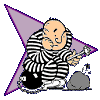
A Guide to Researching Your Convict Ancestors
Another Perth DPS Project
|
| |
|
All the Convict Ships NSW Convict Women Convict Tales |
|
 |
A Guide to Researching Your Convict Ancestors Another Perth DPS Project |
|
|||||
| Research Guide | Gangs | Censuses & Musters | Serendipity | Links | Bibliography | Glossary | Claytons Convicts | Quiz | Project | |||||||||||
Parkhurst Boys 1842-1862 |
 Use Search Box above to find a Parkhurst Boy |
Ship's Name Departed Arrived Port Free App T/L 3rd 4th Exile Total Comments
Day Mth Year Day Mth Year
Simon Taylor 28 04 1842 20 08 1842 Swan River .. 18 .. .. .. .. 18 ... ... ... ... ...
St George 31 05 1842 25 11 1842 New Zealand 35 57 .. .. .. .. 92 ... ... ... ... ...
Shepherd 19 06 1843 26 10 1843 Swan River .. 28 .. .. .. .. 28 ... ... ... ... ...
Mandarin 21 06 1843 16 10 1843 Tasmania 11 .. 40 .. .. .. 51 ... ... ... ... ...
14 11 1843 New Zealand 22 .. 9 .. .. .. 31 ... ... ... ... ...
Halifax Packet 20 08 1844 11 12 1844 Swan River .. 18 .. .. .. .. 18 ... ... ... ... ...
Strathedin 03 08 1845 25 12 1845 Tasmania .. .. 32 21 21 .. 74 ... ... ... ... ...
Cumberland 30 09 1845 26 01 1846 Swan River .. 12 .. .. .. .. 12 ... ... ... ... ...
Maitland 22 05 1846 27 10 1846 Port Phillip .. .. .. .. .. 70 70 ... ... ... ... ...
Thomas Arbuthnot 11 01 1847 04 05 1847 Port Phillip .. .. .. .. .. 89 89 ... ... ... ... ...
Joseph Somes 25 05 1847 10 09 1847 Port Phillip .. .. .. .. .. 84 84 ... ... ... ... ...
Marion 17 09 1847 25 01 1848 Port Phillip .. .. .. .. .. 125 125 ... ... ... ... ...
Orient 23 11 1847 20 03 1848 Swan River .. 51 .. .. .. .. 51 ... ... ... ... ...
Eden 09 03 1848 04 02 1849 Port Phillip .. .. .. .. .. 62 62 ... ... ... ... ...
Ameer 01 11 1848 11 02 1849 Swan River .. 50 .. .. .. .. 50 ... ... ... ... ...
Ship's Name Departed Arrived Port Free App T/L 3rd 4th Exile Total Comments
Day Mth Year Day Mth Year
Hashemy 24 11 1848 .. .. 1849 Tasmania .. .. 29 .. .. .. 29 Six boys died of cholera and never arrived in Tasmania; arrived in NSW on 9/6/1849
Randolf 18 01 1849 09 08 1849 Port Phillip .. .. 85 .. .. .. 85 ... ... ... ... ...
Mary 04 07 1849 24 10 1849 Swan River .. 53 .. .. .. .. 53 ... ... ... ... ...
Adelaide 03 08 1849 29 11 1849 Tasmania .. .. .. .. .. 30 30 ... ... ... ... ...
Blenheim 01 04 1850 24 07 1850 Tasmania .. .. 85 .. .. .. 85 ... ... ... ... ...
Maria Somes 30 04 1850 09 08 1850 Tasmania .. .. 30 .. .. .. 30 ... ... ... ... ...
Nile 26 06 1850 03 10 1850 Tasmania .. .. 30 .. .. .. 30 ... ... ... ... ...
Rodney 25 08 1850 28 11 1850 Tasmania .. .. 40 .. .. .. 40 ... ... ... ... ...
Mermaid 01 01 1851 15 05 1851 Swan River .. .. .. .. .. 43 43 Sent to Western Australia to work on Public Works projects
Lady Kennaway 05 02 1851 28 05 1851 Tasmania & NI .. .. .. .. .. .. .. ... ... ... ... ...
Pyrenees 30 03 1851 28 06 1851 Swan River .. .. .. .. .. 29 29 ... ... ... ... ...
Minden 07 07 1851 18 10 1851 Swan River .. .. .. .. .. 30 30 ... ... ... ... ...
Aboukir .. .. 1851 15 12 1851 Tasmania .. .. .. .. .. .. .. ... ... ... ... ...
Fairlie .. .. 185. 02 03 1852 Tasmania .. .. .. .. .. .. .. ... ... ... ... ...
Equestrian .. .. 1852 19 08 1852 Tasmania .. .. .. .. .. .. .. ... ... ... ... ...
Oriental Queen .. .. 1852 13 10 1852 Tasmania .. .. .. .. .. .. .. ... ... ... ... ...
Dudbrook .. .. 1852 07 02 1853 Swan River .. .. .. .. .. 1 1 ... ... ... ... ...
Lincelles .. .. 1861 28 01 1862 Swan River .. .. .. .. .. 1 1 ... ... ... ... ...
Mermaid 15 05 1851 43 boys arrived at the Swan River for Public Works projects Pyrenees 28 06 1851 29 boys arrived at the Swan River Minden 18 10 1851 30 boys arrived at the Swan River Dudbrook 07 02 1853 1 boy arrived at the Swan River Lincelles 28 01 1862 1 boy arrived at the Swan River
| |||||||||||||||||||||||||||||||||||||||||